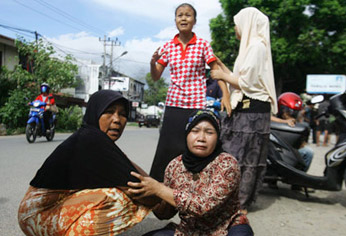|
Urban violence in developing countries:
Women more at risk than men
Local authorities are looking for ways to make Asian cities safer for
women, including lighting their streets, upgrading rest rooms and
training officials. Sometimes it is a broken street light or a neglected
public bathroom.
At other times it is a darkened pathway to a bus stop or an ignorant
police officer. These are a few of the elements that make a city
dangerous for women. Government officials around Asia are increasingly
looking to better understand how to make their cities safer for women
through complex urban re-structuring and simple fixes.
 The need for solutions is urgent. According to the United Nations,
women in developing countries are twice as likely as men to be victims
of urban violence. The problem is particularly acute in rapidly
urbanising Asia. The need for solutions is urgent. According to the United Nations,
women in developing countries are twice as likely as men to be victims
of urban violence. The problem is particularly acute in rapidly
urbanising Asia.
In South Asia, where a series of violent incidents against women has
put a spotlight on the issue, the number of people living in cities is
projected to grow from 549 million in 2010 to 875 million in 2030,
according to the report Gender and Urban Poverty in South Asia.
Women are particularly vulnerable to the risks associated with urban
poverty, according to executive director of National Resource Centre for
Women in India, Rashmi Singh.
These risks are heightened by infrastructure problems, such as public
toilets that are dark with broken doors and no attendants, poorly lit
areas, and a lack of safe and efficient public transportation.
Public spaces that are dominated by men often make women feel unsafe
and unwelcome, even when passing nearby. This is exacerbated by the
tolerance of sexual harassment, which makes women feel threatened, and
the trivialisation by some poorly trained police officers toward
complaints by women.
In addition to outright violence, these problems also create an
atmosphere of fear for women. This can restrict their access to
employment and education opportunities.
Meeting these issues has gone beyond the work of city leaders. It has
become a global movement. World leaders are factoring in violence
against women as they look to formulate the development goals that will
succeed the Millennium Development Goals after 2015, said India's
Minister of State for Women and Child Development, Krishna Tirath during
the recent seminar, Safe Cities For Women - Reclaiming Public Spaces, at
the Asian Development Bank headquarters in Manila.
The Safer Cities program, organised by UN-Habitat, calls upon
officials in developing countries to prevent crime and violence against
women - including public harassment and abuse within the home - through
the use of advocacy and training.
This effort includes improving the city's physical environment,
including better street lighting and safer transportation options,
developed with the consultation and participation of women in the
community.
To address the attitudes that tolerate the harassment of women,
cities are encouraged to including gender sensitisation training in
their crime prevention programs, and the development of services
specifically for women affected by violence. |

